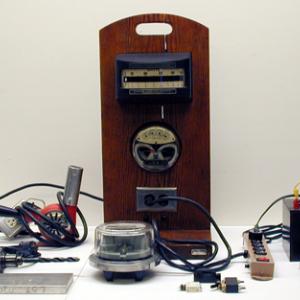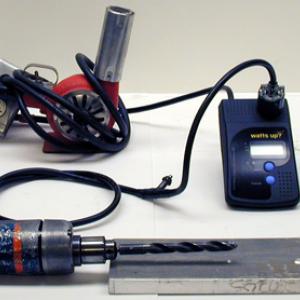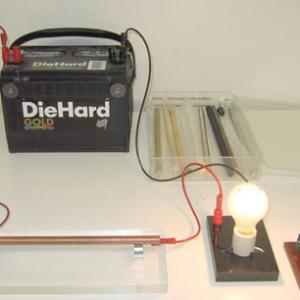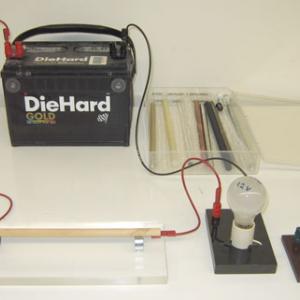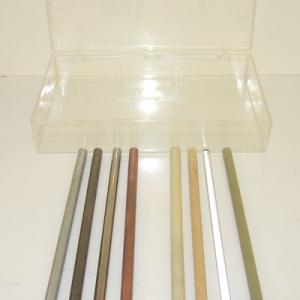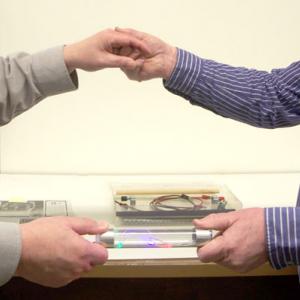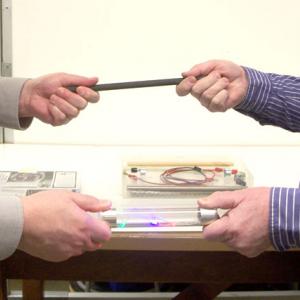College of Liberal Arts & Sciences
5F15.15 - Household Electronics, Circuits, Insulators, & Conductors
Plug in the mounted watt meter unit. Plug the 1000 watt light bulb directly into the Variac and the Variac into the mounted watt meter socket. Now as the Variac is turned up the meter functions may be observed. Note that there is some current flow even when the Variac is turned to the zero position. This is a normal Variac characteristic.
Plug the power strip into the watt meter unit. Plug the Variac into the power strip and the 1000 watt light bulb into the Variac. Turn up the Variac and observe that when the power usage reaches about 1 and 1/2 times the circuit breaker value the breaker will trip.
The watts up meter may be used in place of the wooden mounted watt meter with some precautions. The big drawback is that this meter must have 120 volt input or the LCD functions do not operate.
Common conductors and non-conductors may be shown using a battery, rods, light bulb, and rod holder. While the conductors or non-conductors may be snapped into the holder, it is not necessary for the demonstration to work. Just lay the rod on top of the contacts to see if they are either conducting or non-conducting. It is especially recommended that you do not try to snap the carbon rod into the holders as this will probably break the rod.
- Pathom Vongvizay, Pongkaew Udomsamuthirun, Siriluk Ruangrungrote, Tunyanop Nilkamjon, Suppanyou Meakniti, Thitipong Kruaehong, "Apply A Smartphone's Magnetometer to Measure the AC Current of Electrical Equipment", TPT, Vol. 63, #2, Feb. 2025, p. 130.
- Fabian Beil, Michael Thees, Sebastian Kapp, Jochen Kuhn, "A Dynamic Electron Model for Teaching Electric Circuits", TPt, Vol. 61, #1, Jan. 2023, p. 10.
- William H. Baird, Jeffery Secrest, and Clifford Padgett, "Electrical Power Quality - What's Behind the Outlet?", TPT, Vol. 55, #6, Sept. 2017, p. 347.
- David Bonner, "Establishing Real‐World Connections for a Better Understanding of Circuits", TPT, Vol. 47, #8, Nov. 2009, p. 490.
- Stan Eisenstein and Jeff Simpson, “'Dissection' of a Hair Dryer", TPT, Vol. 46, #9, Dec. 2008, p. 532.
- William P. O'Brien Jr., "Hassle-Free Energy Consumption Measurements of Electrical Devices", TPT, Vol. 46, #5, May 2008, p. 310.
- Steve Dail, "Safer Plugs for Measuring Wattage", TPT, Vol. 45, #8, Nov. 2007, p. 468.
- Dick Heckathorn, "No-Shock Alternative", TPT, Vol. 45, #6, Sept. 2007, p. 326.
- John J. Lynch, "Wattage: Household Appliances", TPT, Vol. 45, #4, Apr. 2007, p. 249.
- Robert Johns, "Simplifying AC-Current Measurements", TPT, Vol. 39, #5, May 2001, p. 314.
- Willem H. van den Berg, "Energy Conversion by an Electric "Space Heater"", TPT, Vol. 36, # 6, Sept. 1998, p. 376.
- Sarah Fay and Angela Portenga, "Hey You! Shut the Refrigerator Door!", TPT, Vol. 36, #6, Sept. 1998, p. 336.
- Lawrence Ruby and John Hunt, "Understanding Modern Electrical Protective Devices", TPT, Vol. 35, #7, Oct. 1997, p. 432.
- H. Richard Crane, "On Electric Shocks and Spinning Eggs", TPT, Vol. 27, #4, Apr. 1989, p. 300.
- Paul Hewitt, "Figuring Physics: Power Lines", TPT, Vol. 28, #2, Feb. 1986, p. 112, also A Potpourri of Physics Teaching Ideas - Electricity and Magnetism, p. 170.
- H. Richard Crane, "A New Department + Light Dimmer", TPT, Vol. 21, #4, Apr. 1983, p. 254.
- Courtney Lantz, Charles H. Anderson, and S. Bozowski, "Why is the AC Power Line Grounded?", TPT, Vol. 18, #4, Apr. 1980, p. 314, also A Potpourri of Physics Teaching Ideas - Electricity and Magnetism, p. 149.
- John L. Roeder, "Activity 12. Using Less Fuel to Heat and Cool Your Home", Teaching About Energy, p. 151.
- John L. Roeder, "Activity 11. Energy "Used" in a Day", Teaching About Energy, p. 146.
- Martin C. Sagendorf, "Volts/Amperes/Watts/Kilowatt Hours", Physics Demonstration Apparatus, 2009, p. 67.
- Borislaw Bilash II and David Maiullo, "Pop-It!", A Demo a Day: A Year of Physics Demonstrations, p. 282.
- Ron Hipschman, "Watt's the Difference", Exploratorium Cookbook III, 156.1 - 156.3.
- Sara Stein, "Drifting Electrons", The Science Book, p. 228.
- Rudolf F. Graf, "Build a Conductivity Tester", Safe and Simple Electrical Experiments, p. 106.
- Herb Strongin, “Batteries, Bulbs, and Circuits“, Science on a Shoestring, p. 154.
Disclaimer: These demonstrations are provided only for illustrative use by persons affiliated with The University of Iowa and only under the direction of a trained instructor or physicist. The University of Iowa is not responsible for demonstrations performed by those using their own equipment or who choose to use this reference material for their own purpose. The demonstrations included here are within the public domain and can be found in materials contained in libraries, bookstores, and through electronic sources. Performing all or any portion of any of these demonstrations, with or without revisions not depicted here entails inherent risks. These risks include, without limitation, bodily injury (and possibly death), including risks to health that may be temporary or permanent and that may exacerbate a pre-existing medical condition; and property loss or damage. Anyone performing any part of these demonstrations, even with revisions, knowingly and voluntarily assumes all risks associated with them.
